
John Francis Sartorius (fl. 1775-1831), was an English painter of horses, horse-racing and hunting scenes, a member of the celebrated Sartorius family of artists. [1]

John Francis Sartorius (fl. 1775-1831), was an English painter of horses, horse-racing and hunting scenes, a member of the celebrated Sartorius family of artists. [1]
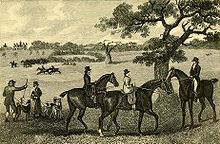
John Francis was the son of artist John Nott Sartorius and grandson of Francis Sartorius. His younger brother Francis Sartorius Jr. ("the Younger") was a marine artist. He was less successful than his father with regard to the number of his patrons, though his thorough knowledge of sport is exemplified in his sporting pictures. He first exhibited at the Royal Academy in London in 1802, when he was residing at 17 King Street, Holborn. Afterwards he sent occasional contributions until 1827, the total number of pictures exhibited by him being 16.
Several of his paintings were engraved in The Sporting Magazine but as his father's works were appearing in the same periodical, and John Scott was engraving for both, it is somewhat difficult to differentiate the son's pictures from the father's, particularly as many of the plates were signed 'Sartorius' only. One of the best known of his pictures is 'Coursing in Hatfield Park,' exhibited at the Royal Academy in 1806, and depicting Emily Cecil, Marchioness of Salisbury, who rode daily in the park up to her eighty-sixth year.

John Constable was an English landscape painter in the Romantic tradition. Born in Suffolk, he is known principally for revolutionising the genre of landscape painting with his pictures of Dedham Vale, the area surrounding his home – now known as "Constable Country" – which he invested with an intensity of affection. "I should paint my own places best", he wrote to his friend John Fisher in 1821, "painting is but another word for feeling".

George Stubbs was an English painter, best known for his paintings of horses. Self-trained, Stubbs learnt his skills independently from other great artists of the 18th century such as Reynolds and Gainsborough. Stubbs' output includes history paintings, but his greatest skill was in painting animals, perhaps influenced by his love and study of anatomy. His series of paintings on the theme of a lion attacking a horse are early and significant examples of the Romantic movement that emerged in the late 18th century. He enjoyed royal patronage. His painting Whistlejacket hangs in the National Gallery, London.

Sawrey Gilpin was an English animal painter, illustrator, and etcher who specialised in paintings of horses and dogs. He was made a Royal Academician.
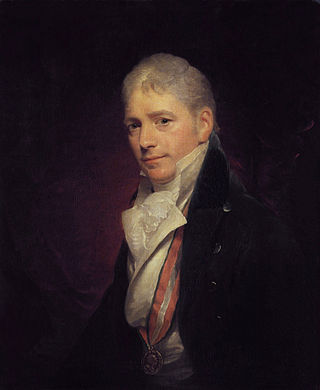
Sir Peter Francis Lewis Bourgeois RA was an English landscape painter and history painter, and court painter to king George III of the United Kingdom.

William Collins was an English landscape and genre painter. His sentimental paintings of poor people enjoying nature became a posthumous high fashion, notably in the 1870s when his market price rose higher than Constable and stayed so until 1894. Turner, his model, far exceeded him in value.

Henry Thomas Alken was an English painter and engraver chiefly known as a caricaturist and illustrator of sporting subjects and coaching scenes. His most prolific period of painting and drawing occurred between 1816 and 1831.
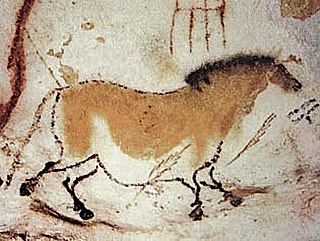
Horses have appeared in works of art throughout history, frequently as depictions of the horse in battle. The horse appears less frequently in modern art, partly because the horse is no longer significant either as a mode of transportation or as an implement of war. Most modern representations are of famous contemporary horses, artwork associated with horse racing, or artwork associated with the historic cowboy or Native American tradition of the American West. In the United Kingdom, depictions of fox hunting and nostalgic rural scenes involving horses continue to be made.
Joseph William Allen was an English landscape painter and art teacher, who was also active in the founding of the Society of British Artists.

Augustus Edwin Mulready was an English genre painter whose work often depicted London street scenes with urchins and flower-sellers.

John E. Ferneley, was an English painter who specialised in portraying sporting horses and hunting scenes. Although his rendition of horses was stylised, he is regarded as one of the great British equine artists, second perhaps only to George Stubbs.

Charles Towne (1763–1840) was an English painter of landscapes, horses and other animals, horse-racing and hunting scenes.
James Barenger (1780–1831) was an English animal painter and illustrator.
Henry Barraud was a British portrait, subject and animal painter.

William Barraud was an English animal painter and illustrator, the brother of Henry Barraud, with whom he collaborated on many works.

John Sartorius was an Anglo-German animal painter, the first of four generations of the celebrated Sartorius family of artists. He should not be confused with his great-grandson John Francis Sartorius.
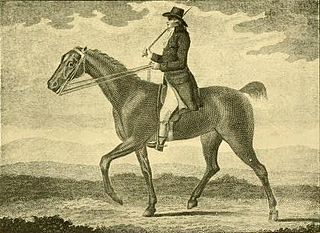
Francis Sartorius was an English painter of horses, horse-racing and hunting scenes, of the celebrated Sartorius family of artists. Also known as Francis Sartorius the Elder to distinguish him from his grandson Francis Sartorius Jr..

John Nost Sartorius (1759–1828), was an English painter of horses, horse-racing and hunting scenes. He is considered the best-known and prolific of the Sartorius family of artists.
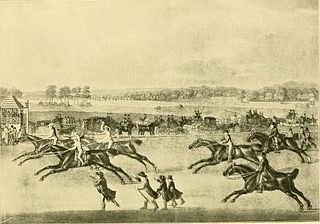
The Sartorius family of the 18th–19th centuries included several generations of English artists—of German origin—who mainly specialised in painting horses, horse-racing and hunting scenes:

James Hayllar (1829–1920) was an English genre, portrait and landscape painter. Four of his daughters Edith Hayllar, Jessica Hayllar, Mary Hayllar and Kate Hayllar were also notable painters.
William Walker Morris was a British nineteenth-century painter of the Victorian period who worked in Greenwich and Deptford, England, and was known particularly for his bucolic genre oil paintings depicting sporting and homestead life, with an emphasis on hunting dogs. His works draw upon the imagery of life in the Scottish Highlands. He died at some time from 1867 to 1881.
Gilbey, Sir Walter. Animal painters of England from the year 1650, volume 2 (London: Vinton & Co., 1900).